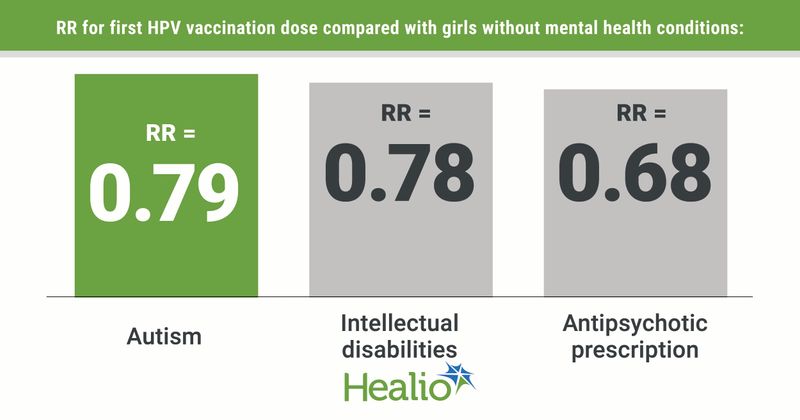HPV vaccine coverage lower among girls with mental health diagnoses
Key takeaways:
- Girls with autism and intellectual disabilities had lower vaccination coverage than their peers.
- Most girls who received their first dose also received their second, regardless of mental health status.
Girls with diagnosed mental health conditions had lower HPV vaccination coverage than their peers without mental health conditions, according to a study published in The Lancet Public Health.
“Despite documented mental illness-related disparities in cervical cancer screening and incidence, insufficient data exist on differences in cervical cancer prevention strategies, such as HPV vaccination,” Kejia Hu, PhD, postdoctoral researcher at the Institute of Environmental Medicine at the Karolinska Institute in Stockholm, and colleagues wrote. “We aimed to investigate the association of mental illness and neurodevelopmental conditions among girls and their parents with uptake of HPV vaccination in Sweden.”

The population-based cohort study included 115,104 girls who were eligible to receive HPV vaccines through the Swedish school-based HPV vaccination program. The program offers the first HPV vaccine dose to girls aged 10 to 13 years and a second dose up to 12 months later.
The primary outcomes were girls receiving their first dose before their 14th birthday and their second dose before their 15th birthday.
Almost 2% (2,211) of girls had been diagnosed with a mental health condition by a specialist, and 18.4% were exposed to parental mental health conditions.
Overall, 80.7% of girls received their first dose when they turned 14 years. Girls with mental health conditions were less likely to get their first HPV vaccine dose on time (adjusted RR = 0.89; 95% CI, 0.87-0.91). Girls with autism and intellectual disabilities had the lowest rates (aRR = 0.79; 95% CI, 0.75-0.85; and aRR = 0.78; 95% CI, 0.73-0.83, respectively). Those who were prescribed psychotropic medications also had lower vaccine coverage (aRR = 0.93; 95% CI, 0.92-0.95), especially girls taking antipsychotics (0.68; 95% CI, 0.56-0.82).
Girls who were exposed to parental mental health conditions were slightly less likely to get their first vaccine dose compared with girls who had no exposure (aRR = 0.98; 95% CI, 0.98-0.99).
Of the 92,912 girls who received their first HPV vaccine dose, 95% received their second dose before their 15th birthday. Among girls with mental health conditions, 93.1% received their second dose compared with 95.1% of girls without mental health conditions.
According to the researchers, HPV vaccination coverage in Sweden was 91% in 2023. Meanwhile, the CDC reported that coverage in the United States has plateaued. In 2022, 62.6% of adolescents were up to date on HPV vaccination, and coverage declined slightly to 61.4% in 2023.
“Our study emphasizes the need for targeted interventions to ensure equitable health care for all children,” Hu said in a press release. “All girls should have equal access to life-saving vaccines regardless of their mental health status.”
References:
- Hu K, et al. Lancet Public Health. 2024;doi:10.1016/S2468-2667(24)00182-8.
- Lower HPV vaccination coverage among girls with mental health conditions. https://www.eurekalert.org/news-releases/1056030. Published Aug. 28, 2024. Accessed Sept. 5, 2024.
